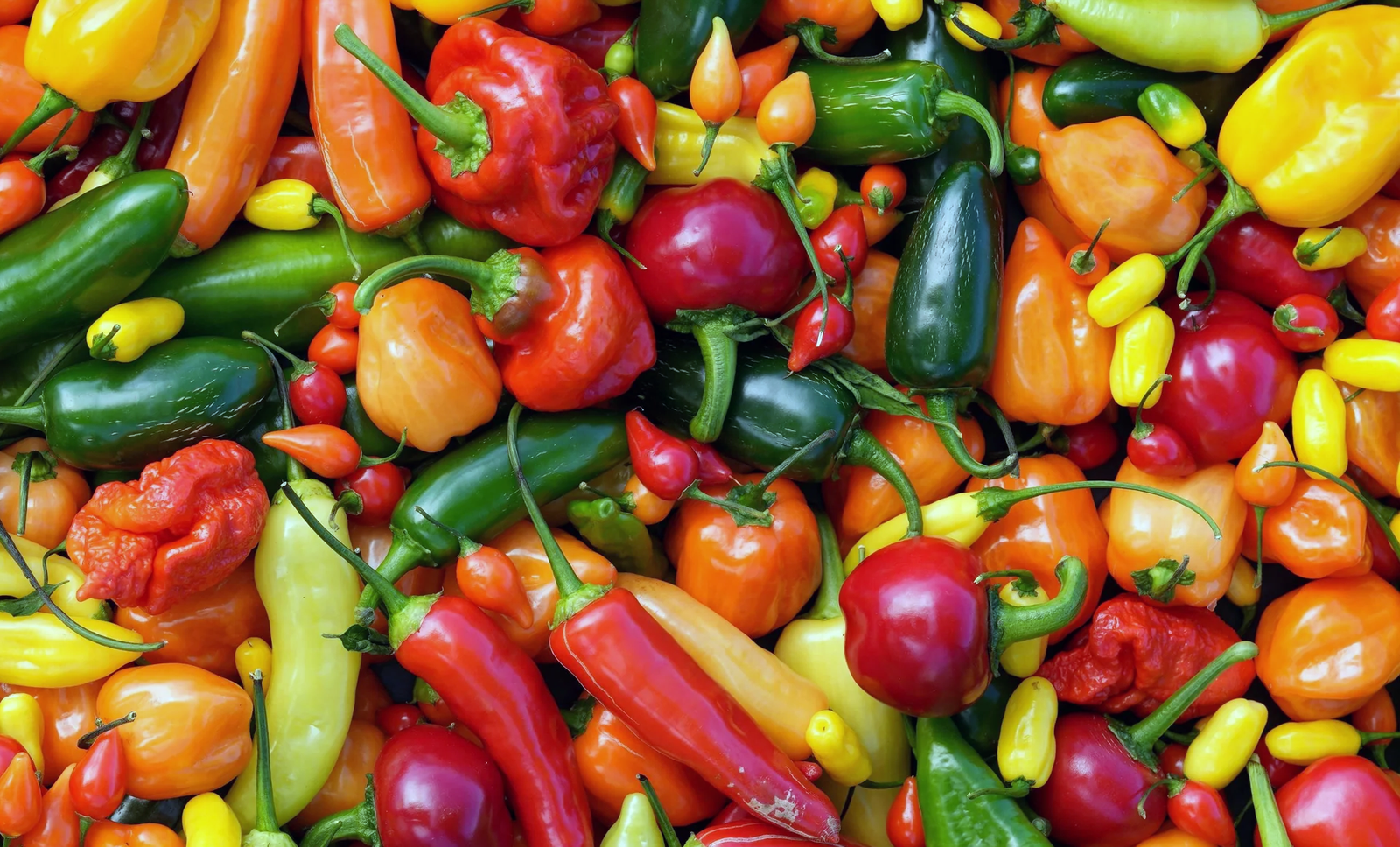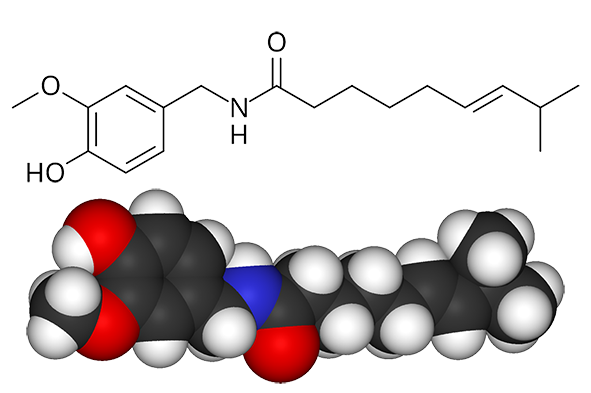FabulousFusionFood's Chilli-based Recipes 13th Page
 A mixture of different chilli peppers.
A mixture of different chilli peppers.
Welcome to FabulousFusionFood's Chilli-based Recipes Page — The recipes presented here all contain chilli peppers as a main ingredient. Chillies are the fruit of the chilli plant. Along with black pepper, they are unique spices in that they impart 'heat' to a dish without any associated bitterness. The dried and powdered fruit along with the fresh fruit and the dried fruit are all used as spices. As well as their capsaicin induced heat, chillies (depending on the variety or cultivar) can also imbue a dish with a fruity flavour. Smoked chillies are also used to impart a smokiness as well as heat to a dish.
Chilli peppers, also spelled chile or chili (from Classical Nahuatl chīlli [ˈt͡ʃiːlːi]) and known as hot peppers, are varieties of berry-fruit plants from the genus Capsicum, which are members of the nightshade family Solanaceae, cultivated for their pungency. Chilli peppers are widely used in many cuisines as a spice to add "heat" to dishes. Capsaicin and the related capsaicinoids give chillies their intensity when ingested or applied topically. Chilli peppers exhibit a range of heat and flavours. This diversity is the reason behind the availability of different types of chilli powder, each offering its own taste and heat level.
Chilli peppers originated in Central or South America and were first cultivated in Mexico. European explorers brought chillies back to the Old World in the late 16th century as part of the Columbian Exchange, which led to the cultivation of multiple varieties across the world for food and traditional medicine. Five Capsicum species have been widely cultivated: annuum, baccatum, chinense, frutescens, and pubescens.
 The capsaicin molecule, chemical structure (top) and space-filling model (bottom).
The capsaicin molecule, chemical structure (top) and space-filling model (bottom).
When peppers are consumed by mammals such as humans, capsaicin binds with pain receptors in the mouth and throat, potentially evoking pain via spinal relays to the brainstem and thalamus where heat and discomfort are perceived. However, birds are unable to perceive the hotness and so they can eat some of the hottest peppers. The intensity of the "heat" of chillies is commonly reported in Scoville heat units (SHU), invented by American pharmacist Wilbur Scoville in 1912. Historically, it was a measure of the dilution of an amount of chilli extract added to sugar syrup before its heat becomes undetectable to a panel of tasters; the more it has to be diluted to be undetectable, the more powerful the variety, and therefore the higher the rating. Since the 1980s, spice heat has been assessed quantitatively by high-performance liquid chromatography (HPLC), which measures the concentration of heat-producing capsaicinoids, typically with capsaicin content as the main measure
The alphabetical list of all the chilli-based on this site follows, (limited to 100 recipes per page). There are 1263 recipes in total:
Page 13 of 13
| Trinidadian Green Seasoning with Cuban Oregano Origin: Trinidad | Victorian Chicken Country Captain Origin: Anglo-Indian | Winter Parsnip Stew Origin: Czech |
| Trinidadian Hot Pepper Sauce Origin: Trinidad | Victorian Cussoondee Kasundi Origin: Anglo-Indian | Wonchoi Origin: Ghana |
| Trinidadian Turkey Curry Origin: Trinidad | Victorian Essence of Chillies Origin: Anglo-Indian | Wouré Burakhè Magilinri (Sweet Potato Leaf Sauce) Origin: Guinea |
| Tunisian Byesar (Tunisian Broad Bean Dip) Origin: Tunisia | Victorian Fish Molee Origin: Anglo-Indian | Xató (Salt Cod and Tuna Salad) Origin: Spain |
| Tunisian Harissa Origin: Tunisia | Victorian Jujube Long Plum Pickle Origin: Anglo-Indian | Xerém (Cape Verdean Pap) Origin: Cape Verde |
| Tunisian Spiced Lamb Balls Origin: Tunisia | Victorian Tomato Chutney Origin: Anglo-Indian | Xinjiang Lamb Casserole Origin: China |
| Turbot in Kerala Red Curry Sauce Origin: India | Vindaloo Curry Paste Origin: India | Xinxim (Brazilian Chicken and Crayfish in Peanut Sauce) Origin: Brazil |
| Turkey and Yam Pepper Soup Origin: Nigeria | Vindaloo Curry Spice Powder Origin: India | Yétissé de Poulet (Chicken Yétissé) Origin: Guinea |
| Turkey Vindaloo Curry Origin: Fusion | Vindaloo Masala Origin: Britain | Yétissé de Tilapia (Tilapia in Aubergine Sauce) Origin: Guinea |
| Udang Masak Lemak Nenas (Pineapple Prawn Curry) Origin: Malaysia | Vinegar and Oil Pickled Mushrooms Origin: Britain | Yam with Greens, Onion, and Okra Origin: Nigeria |
| Ugandan Matooke Origin: Uganda | Wagasi in Sauce Origin: Benin | Yassa Poulet (Chicken Yassa) Origin: Senegal |
| Unakkameen Thenga Chammanthy (Dry Fish Chutney) Origin: India | West African Curry Powder Origin: West Africa | Yataklete Kilkili (Ethiopian Ginger Vegetables) Origin: Ethiopia |
| Upma Origin: Britain | West African Fish Rub Origin: West Africa | Yebeh (Yam and Fish in Red Palm Oil) Origin: Sierra Leone |
| Urap (Steamed Vegetables with Coconut) Origin: Brunei | West Indian Pumpkin Curry Origin: Caribbean | Yebeh Stew Origin: Sierra Leone |
| Vaca Atolada (Beef Ribs with Cassava) Origin: Brazil | West Sumatran Fish Curry Origin: Sumatra | Yen Thongba (Manipuri Chicken Curry) Origin: India |
| Vegetable Tagine Origin: North Africa | Wet Fry Pork, Kenyan Style Origin: Kenya | Yoghurt Sharbat Origin: India |
| Vegetarian Chili Beans Origin: American | Wethani Kyet (Dry Burmese Pork Curry) Origin: Myanmar | Zafrig (Soup Thickening Base) Origin: Croatia |
| Vegetarian Kibbeh Origin: India | Wethani Kyet II (Dry Burmese Pork Curry II) Origin: Myanmar | Zalatina (Pork in Lemon and Vinegar Jelly) Origin: Cyprus |
| Venison and Dark Chocolate Chili Origin: Fusion | White Chili Origin: America | Zambian Piri Piri Origin: Zambia |
| Viande Nyembwe (Meat Nyembwe) Origin: Gabon | Wild Apple and Chilli Jelly Origin: Britain | Zhoug Origin: Yemen |
| Victorian Brinjal Bhaji Origin: Anglo-Indian | Wild Greens Kimchi Origin: Fusion | Zùlt (Pickled Pigs' Ears) Origin: Aruba |
Page 13 of 13